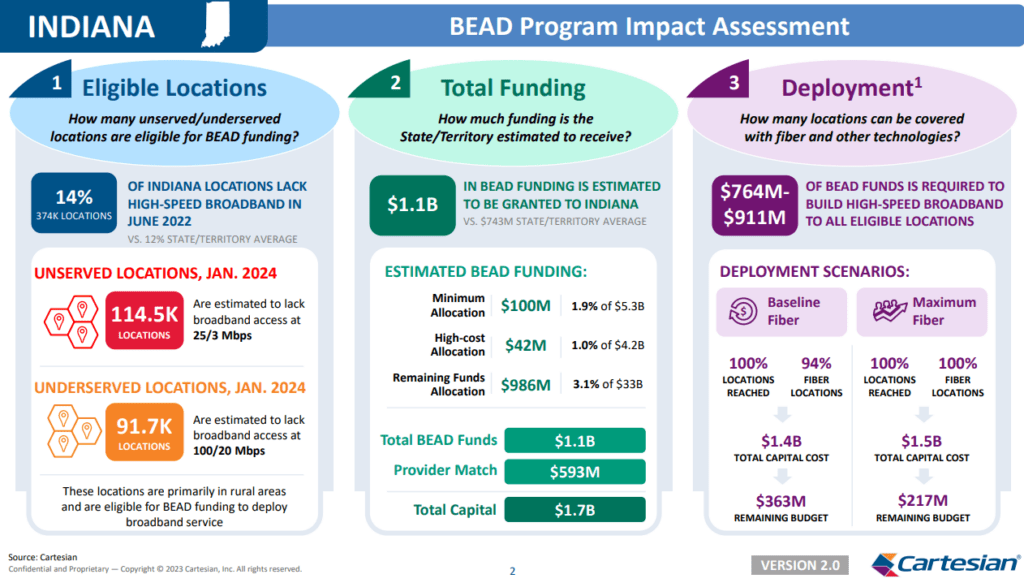New Version Based on FCC Broadband Mapping Data Confirms That BEAD Funds are Sufficient to Bring Fiber to Vast Majority of Unserved and Underserved Locations
PITTSBURGH, February 7, 2023 – ACA Connects President and CEO Grant Spellmeyer today announced that the association has released an updated and more precise version of its widely reviewed BEAD funding analysis from last year. Using location-specific data made available by the FCC, the study estimates how the $42 billion in BEAD program broadband grants will be allocated among the States and Territories and discusses how these entities can use their funds to deliver broadband to eligible locations in their jurisdictions and meet other connectivity goals.
The new version – with ACA Connects working again in tandem with the business consulting firm Cartesian – confirms that there should be sufficient BEAD funding to connect the vast majority of unserved and underserved locations with fiber-to-the-premises (FTTP) technology.
Version 2.0 of the study, like the previous version, includes a national framework and a framework for each State and Territory. These materials have been made available by ACA Connects and Cartesian on the ACA Connects website, at https://acaconnects.org/bead-program-framework/.

“The United States is taking unprecedented steps to close the digital divide once and for all. Version 2.0 of our BEAD framework significantly improves on the first version with better data and refinements to our methodology. Our partner Cartesian has done an excellent job updating our study based on the FCC mapping data, producing an analysis that is more granular and precise than was possible at the time we issued Version 1,” ACA Connects President and CEO Grant Spellmeyer.
The Infrastructure Investment and Jobs Act of 2021 included the Broadband Equity, Access, and Deployment (BEAD) program, more than $42 billion in funding to be distributed among states, territories, Washington, D.C., and Puerto Rico, for projects that support broadband infrastructure deployment and adoption. The National Telecommunications and Information Administration (NTIA) is required to base funding decisions on broadband availability maps created by the FCC, putting a premium on map accuracy to achieve the goals of Congress.
“We commend the FCC and NTIA on their diligence in ensuring these maps are what Congress intended: the definitive source for determining which locations in the U.S. are unserved or underserved. We urge all stakeholders to engage in the FCC’s challenge process as soon as possible so that allocations and awards are based on the most accurate data. That will not only give us the data we need to determine which locations have been left behind, it will maximize use of limited funding to deploy fiber and prevent wasteful overbuilding,” Spellmeyer said.
In Version 2.0 of the study, ACA Connects and Cartesian rely on FCC broadband mapping data and Cartesian’s propriety network cost model to estimate the share of BEAD funding each State and Territory will receive. We then estimate the number of unserved and underserved locations in each State and Territory that will be eligible for support when funds are made available to subgrantees in 2024. Next, based on a reasonable business case, we project that subgrantees will contribute $22 billion in total matching funds on top of the $42 billion appropriated by Congress, which sums to $64 billion in total funds available for BEAD projects. The business case also informs our choice of an “extremely high-cost threshold” of $9,000 per location for purposes of our analysis.
We then outline two national-level deployment scenarios: a “Baseline Fiber” approach that deploys fiber only to locations at or below the extremely high-cost threshold, and a “Maximum Fiber” approach that deploys fiber to additional, higher-cost locations. Under “Baseline Fiber,” 81 percent of eligible locations would receive fiber and the remainder would receive fixed wireless or other technologies, at a total cost of $45 billion. In the “Maximum Fiber” scenario, 87 percent of locations receive fiber and the total cost is $54 billion. In both scenarios, the vast majority of eligible locations receive fiber, and a substantial share of the $64 billion in total available funds is left over for broadband adoption and other initiatives.
One of the most valuable aspects of the ACA Connects/Cartesian study is that it collects data and assesses deployments on a granular State-by-State basis. Version 2.0 finds that, while most States will have sufficient funds to deploy fiber to most or all eligible locations, some may not. The framework thus can be used by States to vary the deployment scenarios to achieve their unique objectives.
“States and Territories face a big task and a tremendous responsibility in awarding BEAD funds to close the digital divide. As new data comes in, we will continue to refine our analysis to provide better and more precise guidance to States and Territories as they consider how best to spend these funds,” ACA Connects’ Spellmeyer said.
ACA Connects is ready to work with State and local government offices to help them understand and apply Version 2.0 of our framework. The analysis for each State and Territory also contains a list of ACA Connects Members that operate in that jurisdiction and whom they should contact. Our Members are experienced broadband providers who have deployed advanced networks to nearly 23 million households, including to more economically challenging locations in rural areas. In addition, over the years, they have successfully used federal, State, and local government funding to deploy broadband connectivity to these communities.
ACA Connects—America’s Communications Association is a trade organization representing approximately 500 smaller and medium-sized, independent companies that provide broadband, video, and phone services covering 29.5 million households. ACA Connects Members operate in every state, providing advanced communications to connect homes, companies, main street, schools, hospitals and more. America’s economic prosperity in smaller communities and rural areas depends on the growth and success of ACA Connects Members, who believe a connected nation is a prosperous nation.


